By Steve Benner for CoinWeek …..
This is the third article in a series on the Greek colonies on the northern coast of the Black Sea (Euxine Sea). The first article was on Olbia, the second was on Tyras and Chersonesus, and this one covers the cities of Theodosia, Gorgippia, and Phanagoria in the Cimmerian Bosporos.

As mentioned previously, most of the colonies in the area that is now southern Ukraine and Russia were settled during the seventh through fifth centuries BCE. The soil in this region was very rich, referred to as the “Black Land”, and cities’ economies were based on fishing, agriculture, viticulture, slaves, and manufacturing. The area’s products were not only traded with the Greek cities of Asia Minor and Greece but also with local tribes, like the Scythians, Sindians, Sarmatians, Taurians, and Maeotians. Wine, weapons, vases, sculptures, slaves, and precious textiles passed through their hands, and as a result the cities became very wealthy.
In the second century BCE, local tribes began to raid the colonies, and the cities went into decline. Almost all the cities in this area, like the three herein, became part of the Bosporan Kingdom, established in 480 as a confederation to provide mutual support. The capital was at Panticapaeum (present-day Kerch) and included the Taurian Peninsula (Crimea), the lower Kuban region, and the eastern Azov steppes. The member cities also included Tiritaka, Nymphaeum, Hermonassa, and Tanais. The Kingdom flourished for the next 300 years, first under the Archaeanactid dynasty and then under the Spartocid, reaching its height in the fourth and third centuries.
In the last part of the second century, the Scythians began to raid the kingdom, forcing it to request the help of the Pontic king Mithridates VI in 107 BCE. Mithridates defeated the Scythians and incorporated the kingdom into his empire. When Mithridates died in 63, the Bosporan Kingdom continued but under Roman domination.
Theodosia
Theodosia was founded on the southeastern coast of the Taurian Peninsula originally by Milesian traders in about 570 BCE but was later reinforced by colonists from Heraclea Pontica. It became a trading rival to Panticapaeum and spent the next two hundred years resisting encroachment from the Bosporan Kingdom. In 399/8 (or 370) BCE, it was conquered by the kingdom and became a dependency of Panticapaeum.
Theodosia grew wealthy on the Black Sea grain trade and began issuing its own coins at the end of the fifth century. It was captured by the Scythian king Saumakes in 109 BCE but retaken by Diophantos, Mithridates’ general, in 107. It revolted against its Pontic rulers but was reincorporated into the Bosporan Kingdom, which was now under the watchful eye of Rome.
Theodosia began issuing its own silver coins around 400; the first coins were obols (1 g) and tetartemorions (0.25 g) on the Aigenetic standard of 12.2 grams (g) to the stater. These coins have a male head obverse, and the reverses have a filleted bull’s head either facing right or ¾ right with the city ethnic, QEODEO, all in an incuse square.
About 375 and for a very short time afterward, the city issued two other denominations, which were the hemidrachm and 1/6 siglos (0.5 g) on the Persic standard. The ethnics on these coins were QEODW. No silver coins were issued again until the late fourth or third century BCE when a now rare silver siglos (4.7 g) with a Herakles head obverse and a reverse with a club and QEU was minted.
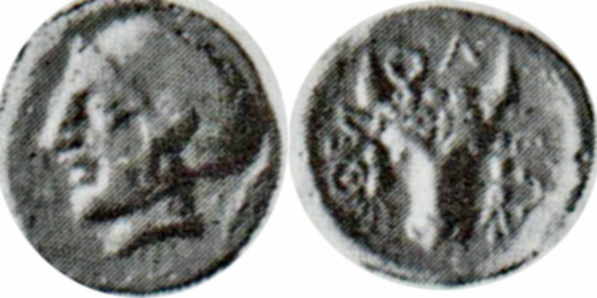
From about 375 to 340, Theodosia issued several small bronze denominations ranging from 0.33 to 2.71 g. These have either a female profile or a bull’s head on the obverse and on the reverse either a bull charging or a six or eight-rayed star with one of the aforementioned ethnics. A large bronze (2.83 to 4.58 g) was minted in the latter half of the third century with an Athena head obverse and a reverse with a club and a bow in a case. The reverse refers to Herakles, who was very popular in the region. There was no coinage struck by Theodosia after the end of the third century.


The bronze coins of Theodosia tend to be a little more expensive than some of the other Greek bronze coins available on the market but are within the budget of most collectors. This is not true of the silver coins, which are very rare and accordingly demand a high price if you can find them.
Gorgippia
Gorgippia is located on the Taman Peninsula across from Theodosia and south of the Kerch Strait. Pontic Greeks established an emporium, Sindikos Limen, in the late seventh century BCE to trade with the Sindic Scythian. Prior to the arrival of more Greek colonists, the site may have been the seat of the Sindic Scythian kings. In the fourth century, Sindikos was incorporated into the Bosporan Kingdom by Leukon I (388-348); the city was refounded and named Gorgippia after his brother. It had fortification walls and temples to Aphrodite, Demeter, and yes, Herakles. Festivals were held in honor of Hermes as well.
The city was known for shipbuilding and became wealthy off its wheat trade, but it also produced wine, pottery, and sculptures. Gorgippia flourished under the control of the Bosporan Kingdom’s Spartokid dynasty. Mithridates VI of Pontus ruled over the kingdom from about 108 until his suicide in 63, when Pompey of Rome reestablished the Bosporan Kingdom under Pharnakes II.
At the end of the fifth century, Gorgippia began to mint silver fractions–such as triobols, diobols, trihemiobols, hemiobols, and tetartemorions–using the Aiginetic standard. The coins show that the issuing authority was the Sandans (SINDWN), and could have been struck either for the inhabitants of Sindikos Limen or for trading with the Sindic Scythians, or for both. The coins feature Herakles or a griffin on the obverse and a horse’s head on the reverse – except for the trihemiobol, which has Herakles (or Scythes?) on the obverse and a male stringing a bow on the reverse. The Scythians were considered great horsemen, and, as mentioned above, Herakles was a popular hero in the region.
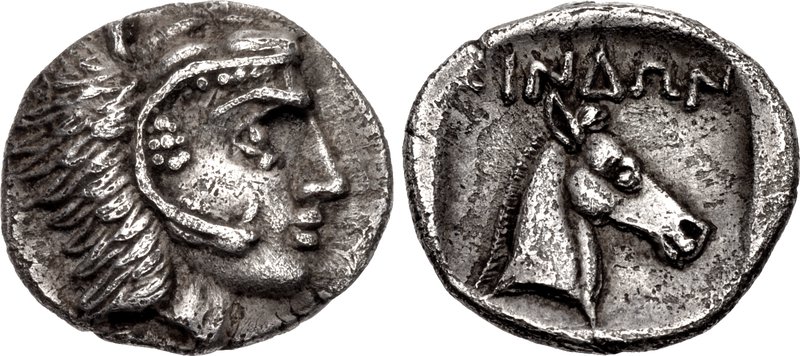
After the fifth century BCE, no coins were struck again until the end of the second and beginning of the first century under the rule of Mithridates, when Attic-weight silver drachms and didrachms began to be issued. The coins now have an ethnic (GORGIPPEWN) that indicates that they were being issued by the Gorgippeans. The drachms were issued first and have Apollo on the obverse and a reverse of a stag leaping right with a thyrsos (a staff of giant fennel covered with ivy vines and leaves topped with a pine cone) behind. The didrachms have Dionysos on the obverse with a wreath and grape cluster on the reverse. The stag and Dionysos were symbols associated with Mithridates, and wine was a major product of the Bosporan cities.
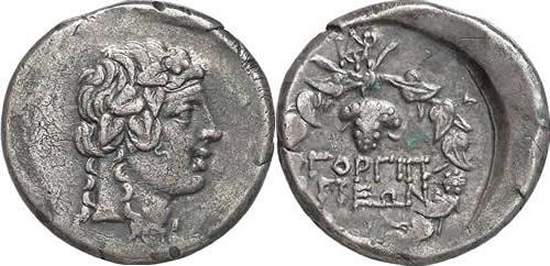
Two types of bronze coins were also struck at this time. One has the Phrygian moon-god Men on the obverse and Dionysos standing on the reverse, again a reference to wine. The other has Apollo on the obverse and a tripod with a thyrsos on the reverse. These bronzes were regularly overstruck on earlier bronze coins.
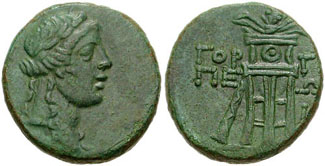
As seen with other coins from this region, the silver coins can be expensive, though unlike Theodosia silver, at least they are available. Bosporan coins similar to the didrachm above sold for about $500 10 years ago. The bronze coins can be purchased at moderate prices, but like other denominations from this region, they don’t seem to come up for sale often.
Phanagoria
Phanagoria was founded around 543 by Teians fleeing the Persian Cyrus’ conquest of Ionia and was named after the leader of the colonists. It is located on the Corocondamitis Archipelago in the Kerch Strait separating the Taman Peninsula from the Crimea. The city was a large emporium for trade through the strait and had an acropolis, agora, gymnasium, temple to Aphrodite, and lower town with a port. About a third of the city is underwater today.
Phanagoria thrived on the trade with the Scythians and the Sindi, becoming the largest city on the peninsula. In the fourth century BCE, it was captured and incorporated into the Bosporan Kingdom, but it also reached its height during the same time period. Soon after its capture, it became the eastern capital of the kingdom with Panticapaeum being the western capital. Its importance increased as Panticapaeum’s decreased and eventually Phanagoria became the main city in the kingdom.
At the end of the second century, Phanagoria sided with the Romans against Mithridates IV and, after being defeated by him, later revolted against his rule. After Mithridates’ death in 63, Phanagoria was a dominant force in the area, being granted autonomy by the Roman general Pompey. It was reabsorbed into the Bosporan Kingdom in the 50/40s BCE.
Phanagoria began minting silver drachms, diobols, obols, and hemiobols to the Persic standard (4.7 g to the siglos drachm) at the end of the fifth century. The obverses have the head of Kabeiros (a group of subterranean deities worshipped in mystery cults), and the reverses have a bull (either the forepart, the head, or the whole body) and a barley seed. The hemiobols have Apollo on the obverse and only a barley seed on the reverse. The city ethnic on the coins is either FA or FANA.
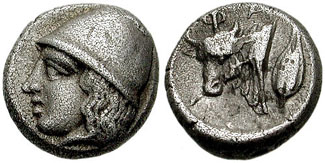
After about 400, Phanagoria did not issue any more silver coins until the end of the second century when it minted drachms with Artemis on the obverse and a rose on the reverse. The rose was to show that the coin was struck to the Rhodian standard (3.2 g to the drachm). The city ethnic is FANAGORITWN. This was struck during the time that Mithridates had taken over the Bosporan Kingdom.
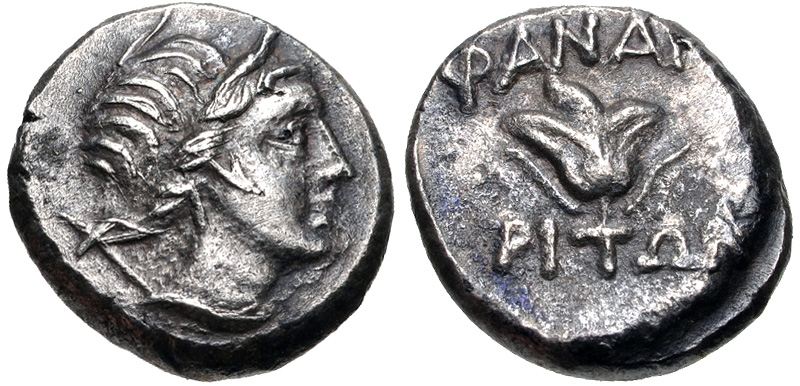
Early in the first century BCE and still during the reign of Mithridates, Phanagoria began to mint didrachms, drachms, and hemidrachms, this time to the Attic standard. The didrachm had Dionysos on the obverse and a bunch of grapes and the city ethnic within an ivy wreath. This is the same coin type as shown above for Gorgippia except, of course, the city ethnic is different. The drachm and hemidrachm have Apollo on the obverse, and the reverse has a filleted thyrsos. This coin type is very similar to that used in Panticapaeum. The city ethnic is the same as the previous drachm.

Late in the second century, Phanagoria introduced bronze civic coinage of two denominations (2.3-8.1 g and 1.92-2.47 g). These are also very similar to Panticapaeum’s coinage with a satyr on the obverse and either a bow and arrows or a thunderbolt. At the start of the next century, new denominations (18.13 g and 2.96-11.77 g) were issued. The large bronze has Men on the obverse and Dionysos standing holding a bunch of grapes on the reverse. In the latter group, two of the coins are similar to those minted by Gorgippia during the same period: one is the same type as shown above and the other is similar to the drachm with the Apollo obverse and stag reverse.
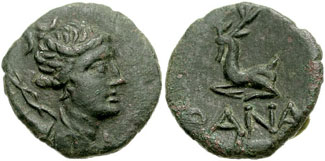
After 70, the bronze coins then stopped being minted until the reign of Asander (49/8-21/0) as head of the Bosporan Kingdom. The coins obverses are Apollo or Artemis, and the reverses are Pegasus, a ship’s ram, or an aphlaston (the upward curving stern of an ancient warship). As with Gorgippia, the bronze coins were usually overstruck.
Unlike the coins of the Theodosia and Gorgippia, the coins of Phanagoria are more common and hence not as expensive. Since they are not as easy to come by as mainland or Ionian Greek coins, the silver coins can be pricey–especially if they date to the fifth century. The bronze coins tend to be more reasonably priced, though a few of them are rare.
* * *
References
Anokhin, V.A. Coins of antique cities of the North-Western Black Sea region. Kyiv (2011).
Cambridge Ancient History, VIII. Rome and the Mediterranean, 218-133 B.C.. Cambridge at University Press (1970).
Grant, Michael. A Guide to the Ancient World: A Dictionary of Classical Place Names. Barnes and Noble (1986).
Head, Barclay V. Historia Numorum: A Manual of Greek Numismatics. Oxford (1887).
Hoover, Oliver D. Handbook of Coins of Northern and Central Anatolia, Pontos, Paphlagonia, Bithynia, Phrygia, Galatia, Lykaonia, and Kappadokia (with Kolchis and the Kimmerian Bosporos), Fifth to First Centuries BC [The Handbook of Greek Coinage Series, Volume 7]. Classical Numismatic Group, LLC (2017).
Hornblower, Simon, and Antony Spawforth, editors. The Oxford Classical Dictionary. Oxford University Press (1996).
McDonald, David. An Introduction to the History and Coinage of the Kingdom of the Bosporus [Classical Numismatic Studies, No. 5]. (2005).
Sear, David. Greek Coins and Their Values, Vol 2: Asia. B.A. Seaby Ltd. (1979).




